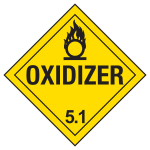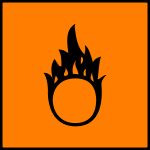Oxidising substances
GHS symbol
Oxidising
hazard symbol O
outdated EU labeling
Oxidising substances support combustion , but are not themselves combustible . They are marked as hazardous substances with the symbol "Oxidizing" and belong to ADR class 5.1 "Inflammatory (oxidizing) substances" as hazardous goods .
Examples: oxygen , oxygen-rich or oxygen-releasing compounds such. B. potassium chlorate and peroxides and the element fluorine , which can displace oxygen from compounds.
Their effect and danger is based on the fact that they supply the oxygen required for combustion and continue to maintain combustion even when there is no oxygen in the air. This is important when extinguishing a fire, because many common extinguishing methods ( foam , carbon dioxide , water mist, sand) aim to exclude the oxygen in the air, which does not help with such fires.
Oxidising substances, on the other hand, are not flammable, they do not react with (further) oxygen.
The danger symbol O is used on containers to mark oxidizing substances; the class 5.1 label is used on transport vehicles. In the event of an accident, the arriving rescue workers can react appropriately. First aiders should point out this danger symbol to the control center when making an emergency call.
swell
- Germany: ChemPrüfV § 2 Abs. 4


